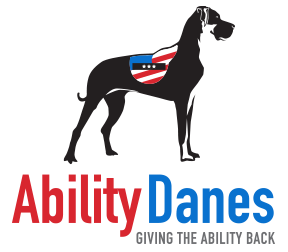Frequently Asked Questions
Ability Danes FAQ
Service Animal FAQ
A service animal is an animal that is individually trained to do work or perform tasks for a person with a disability.
Please do not touch, talk, feed or otherwise distract the dog while he is wearing his harness or vest. You should allow the dog to conc3entrate and perform for the safety of his handler. Do not treat the dog as a pet; give him the respect of a working dog.
It generally takes 1-2 years to train a service dog. The dog must be to mitigate your disability, and must behave appropriately in public to avoid being removed. This means there are two main facets of service dog training: (1) public access behaviors, and (2) disability-related work and tasks.
Service animals can be trained to guide individuals that are blind, alerting individuals who are deaf, pull a wheelchair, alert and protect an individual having a seizure, provide stability and balance assistance or even remind someone to take their medication.
Mobility, guide, hearing, medical alert, and psychiatric service dogs are the most common types.
Companionship. Research shows that service animals impact their handlers beyond their disability-related tasks. One study found that working with service animals leads to better functioning at work, school, and in life overall.
Emotional support animals provide companionship, relieve loneliness, and sometimes help with depression, anxiety, and certain phobias, but do not have special training to perform tasks that assist people with disabilities. Emotional support animals are not limited dogs.
No, there is no requirement for service animals to be certified or wear special identifier. Many do this out of convenience but there is no requirement.
Service animals can only be refused entry or asked to leave if they are out of control and the handler does not take corrective action, or if the animal poses a threat to the health and safety of others.
No. However, the handler will be responsible for any damage the animal may cause.
Depending on the type of animal and the tasks needed, costs can vary from relatively cheap if you do it yourself all the way up to $40,000 if you purchase a trained animal.
The handler may be in trouble. Follow the animal without causing further distress and locate the handler. Ask the handler how they would like to be helped. Do not call 911 unless instructed to or unless the situation requires so.
